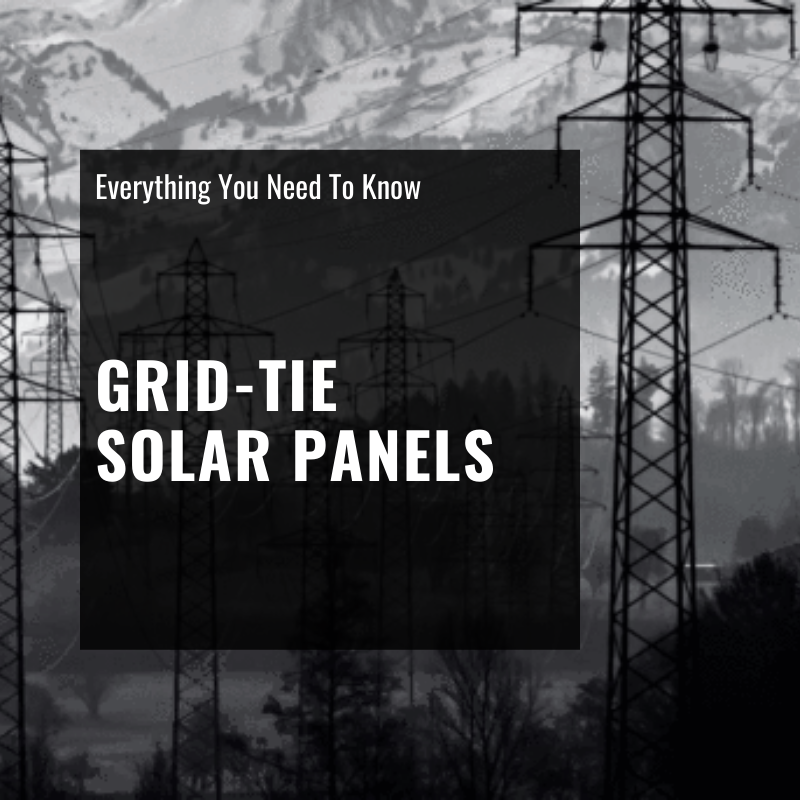
Grid-Tie Solar Panels

Table of Contents
Short on Time? Here’s The Article Summary
The article provides a guide on selecting grid-tie solar panels, emphasizing their benefits and different types available. It highlights monocrystalline panels for efficiency, polycrystalline for environmental friendliness, and thin-film for budget-friendliness. The guide includes steps for choosing the right material, size, and capacity for solar panels, as well as mounting and installation considerations.
It also briefly discusses the limitations of grid-tie systems during power outages and suggests considering off-grid systems for uninterrupted power supply. Overall, the article aims to help readers make informed decisions when selecting grid-tie solar panels for their systems.
Introduction
Are you looking for fantastic grid-tie solar panels to complete your grid-tied solar system? Don’t know which grid-tie solar panels to go with? You’re in luck.
After opening our doors in 2018, we’ve been steadily building a solid reputation as the nation’s number one DIY solar shop. So, we know a lot about solar panels.
Here’s our ultimate guide on how to choose the best grid-tie solar panels for your system.
Why Choose a Grid Tie Solar System?
A grid-tie solar system is an excellent solution for anyone who wants to reduce their current electric bill in an effective, eco-friendly manner.
Like any typical solar power system, a grid-tie solar system will generate electricity while the sun is shining.
However, the main difference is that the system has a direct connection to the local power grid. It will sell any excess electricity that the household doesn’t use to the power company.
If it’s particularly overcast outside, or the sun isn’t shining, you may still need to buy electricity from the grid.
It’s important to remember that a grid-tie solar system will not produce power when the grid is down. Power companies require that a grid-tie solar system stops sending power into the grid during an outage.
Doing this protects the workers from being electrocuted while working on the lines. The only time that a grid-tie solar system will provide electricity during an outage is if you have a backup battery installed with your solar system.
Benefits of a Grid-tie Solar System
- A grid-tie solar system has a fast return on investment.
- A grid-tie solar system can generate an income for homeowners.
- It’s easy to scale a grid-tie system with your budget.
- A grid-tie system is an excellent DIY solution.
Three Steps to Choose the Best Grid Tie Solar Panels

Now that we’ve briefed you on the fundamentals of your grid-tie solar system, it’s time to focus on the best grid-tie solar panels.
Today, there are many different types of solar panels available on the market. Here’s our easy three-step guide on how to choose the best grid-tie solar panels to compliment your system.
Step 1: Choose the right material.
Solar panels come in three different material types. Each type of material has other benefits and comes at its own price range.
So, it’s important to know your budget when selecting the type of solar panel your grid-tie system will be using.
Remember, it’s easy to swap out parts of your solar system as your budget grows.
Monocrystalline solar panels are best for efficiency.
Monocrystalline solar panels are the most efficient type of solar panel available to us. These solar panels are made from incredibly pure silicon.
This pure silicon efficiently converts sunlight into energy and is why these solar panels are so popular.
Because of the pure silicone in these solar panels, they are also the most expensive, and elite panels on the market.
If you’re looking for rugged, efficient monocrystalline solar panels to power your grid-tie system, we suggest looking at this 6x 320W Solar Panel Kit.
This kit contains 6 efficient 320W monocrystalline solar panels that easily connect to your existing grid-tie solar system.
They are also weather-resistant and can withstand some of the harshest conditions, meaning you won’t have to worry about their lifespan or expensive replacements.
Polycrystalline solar panels are the best environmentally-friendly panels.
If you want a more affordable and eco-friendly option, we suggest looking at polycrystalline solar panels.
This type of solar panel also uses silicone to produce energy, but it’s less efficient than monocrystalline solar panels.
A great polycrystalline solar panel, perfect for a grid-tie system, is this 100W solar panel.
This solar panel provides excellent low-light performance on those cloudy days, mornings, and evenings. This performance ensures that your system is running smoothly throughout the day.
Installation is also pretty straightforward as it comes with pre-drilled holes. You can use these holes to mount the solar panel on either a ground mount, Z-brackets, pole mounts, or even tilt mounts.
Thin-film solar panels are the best budget-friendly option.
There’s been a lot of debate around flexible vs. rigid solar panels. Despite the vigorous debate, it’s a well-known fact that thin-film panels are affordable. They tend to be the cheapest option available to us.
We do, however, suggest that you only buy thin-film solar panels for your grid-tied solar system if you need a basic solar system.

A flexible solar panel like the 175W Flexible Solar Panel is a great, affordable solar panel for your grid-tie system.
This flexible solar panel is more than capable of meeting a wide range of applications. Since it can bend up to 248 degrees, you can easily install it where standard panels are inconvenient to mount.
Installation is also quick, as this flexible solar panel weighs 70% less than conventional solar panels.
Step 2: Choose the right size and capacity.
Now that you’ve decided which type of material you want your solar panels to be made from, it’s time to choose the correct size and capacity. The size and power of your solar panel will dramatically influence the cost of the panel.
The secret here is to choose enough solar panels to power your household appliances. You should also be able to fit your new solar panels in the area you want to install them in.
Typically, under ideal conditions, a 100W solar panel will produce 100 watt-hours every hour. A 200W will generate 200-watt hours of electricity every hour.
So, if your grid-tie system is a 400W system, you may need either 4x 100W panels or 2x 200W panels to complete your system. You’ll find that the more watts a solar panel produces, the more expensive it becomes. So, there’s a delicate balance between the number of panels, and the capacity of those solar panels.
Step 3: Mounting and installation
Last but not least, you have to consider mounting and installing your solar panels. There are various options available to you.
Some people prefer using a sturdy roof mount that can resist even strong winds. Other people prefer using a ground mount to install their solar panels on the ground. Bifacial solar panels, on the other hand, should best be installed using a pole.
Your mounting and installation will be determined by the area available to you and the type of property you have.
For instance, solar panels for commercial buildings will have a different mounting method than a grid-tied residential system.
What if a grid-tied system isn’t enough?
A major drawback of using a grid-tie system is that it won’t be able to keep the lights on during a power outage without an expensive backup battery.

If you’re concerned about your grid-tie solution not being a perfect match for your lifestyle, we recommend that you have a look at an off-grid solar system. An off-grid solar system has several excellent benefits over a standard grid-tie system.
Benefits of an off-grid solar system
- You can avoid power outages.
- It’s an independent, clean power source.
- You can expect a fast return on your investment.
- An off-grid system is easy to upgrade and maintain.
Despite popular belief, off-grid solar systems aren’t any more expensive than grid-tied systems. You can go off-grid for as little as $3,200.
This system will ensure that you have light when there’s a power outage or when disaster strikes.
Final thoughts
A grid-tie solar system is a great choice for reducing your energy bills. They’re easy to expand on and maintain.
There’s a type of solar panel for you out there. Perhaps you are drawn to the efficiency of a monocrystalline solar panel.
Or, maybe you prefer the eco-friendly approach of a polycrystalline solar panel. Perhaps your budget is tight, and all you can afford is a flexible solar panel to complete your system.
Whatever your preference, our grid-tie solar panels will keep your system running smoothly.
If you feel concerned that the grid-tied solar system may not be the best solution for your household, get in touch with us, and we’ll help ease your fears.
The Ultimate Solar + Storage Blueprint (Mini Course)
Struggling to understand how solar + storage systems actually work? Looking to build or buy your own solar power system one day but not sure what you need? Just looking to learn more about solar, batteries and electricity?
Join 15,000+ solar enthusiasts breaking free from their energy dependence with this short step-by-step video course that will make you a solar + storage expert. Start your journey to energy independence today.
Who is ShopSolar.com?
ShopSolar.com is the #1 digital platform that enables consumers & businesses to source and purchase complete solar + storage solutions direct, saving you thousands in time, energy and money! With over 40,000+ happy customers, we’re on a mission to make solar simple, transparent and affordable.
Did you find our blog helpful? Then consider checking:
- Diy Solar Panel System Installation Guide: Step by Step
- How Long Does It Take for Solar Panels to Pay for Themselves
- What Can a 100 Watt Solar Panel Power?
- How Many Solar Panels Do I Need to Power My House?
- How to Calculate Solar Panel, Battery, and Inverter Specifications
- How Much Solar Power Do I Need to Run a Refrigerator?
- How Much Do Solar Panels Cost for a 1,500 Square Foot House?
- What Are the Best States for Solar Energy?
- How to Wire a Solar Panel – Connecting Solar Panels Together
- Diy Solar Panel System Installation Guide: Step by Step




Leave a comment